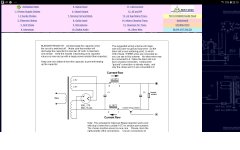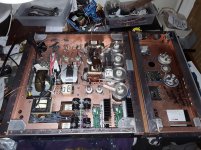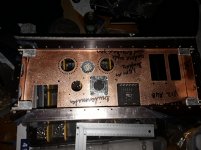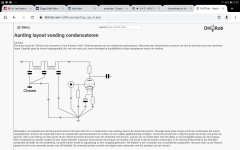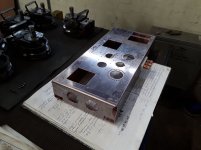I started writing this a few years ago, and have it on a web site: Amp-School.net - Understanding Electronics and Tube Amps
My own attempt to simplify learning tubes from the first basic principles.
My own attempt to simplify learning tubes from the first basic principles.
Newbie Newbie
Hi, my name is David and I have joined here today. I have found this thread very useful as I didn't even do physics at school, which is 40 years ago this year. Anyway, I don't really know the first thing about electronics but got into this DIY hi-fi larc because originally I wanted to be able to reduce the bass on my pc based system so as not to annoy the neighbors so much, I have a flat in a large old house which was originally built in 1690, hence, no soundproofing. I started off by buying a ready-made Little Bear P1 I think it was, it uses a single 6dj8 or a 12au7 and a digital power amp, it sounded ok to me.
Then I bought a cheap 6J1 board and a digital power amp board with high, mid and low tone control and fitted them into some beech wood tea caddies and did some inlaying on the front with Bethlehem Olivewood where the control knobs are. I will upload some photos sometime. So, a friend asks me to build him a phono preamp and I'm now in deep over my head 🙂.
I first purchased a CAT SL-1 clone and the recommended transformer from the Douk store for myself. It came with no instructions and being a lectrodummy I'm stumped as to what to do with it next. I'm just waiting for some tubes to arrive from Holland, 2x JJ ECC802s gold pin, 2x ECC803s gold pins and another ECC83s. I have a Mullard E88CC for the final stage. I need to know whether I need a power supply board for this or do I connect the transformer directly to the board? Any advice or guidance on this project would be most welcome and I thank you in advance 🙂
There are 2 inlets for power on the mainboard, 1 0-250v AC /80ma and 1 6.3V 3A and a ground. I will try and upload some photos of the said board. The other project is a Shure M65 clone for my friend. I have found out that I just connect the transformer straight to the board, I'll see when it arrives, it was from another seller as douk failed to include all the resistors required for the sub-board, the standoffs and a couple of plugs. They weren't very helpful with my queries about the sub-board, I guess it's the language barrier. So, here I am, please be gentle 🙂
Hi, my name is David and I have joined here today. I have found this thread very useful as I didn't even do physics at school, which is 40 years ago this year. Anyway, I don't really know the first thing about electronics but got into this DIY hi-fi larc because originally I wanted to be able to reduce the bass on my pc based system so as not to annoy the neighbors so much, I have a flat in a large old house which was originally built in 1690, hence, no soundproofing. I started off by buying a ready-made Little Bear P1 I think it was, it uses a single 6dj8 or a 12au7 and a digital power amp, it sounded ok to me.
Then I bought a cheap 6J1 board and a digital power amp board with high, mid and low tone control and fitted them into some beech wood tea caddies and did some inlaying on the front with Bethlehem Olivewood where the control knobs are. I will upload some photos sometime. So, a friend asks me to build him a phono preamp and I'm now in deep over my head 🙂.
I first purchased a CAT SL-1 clone and the recommended transformer from the Douk store for myself. It came with no instructions and being a lectrodummy I'm stumped as to what to do with it next. I'm just waiting for some tubes to arrive from Holland, 2x JJ ECC802s gold pin, 2x ECC803s gold pins and another ECC83s. I have a Mullard E88CC for the final stage. I need to know whether I need a power supply board for this or do I connect the transformer directly to the board? Any advice or guidance on this project would be most welcome and I thank you in advance 🙂
There are 2 inlets for power on the mainboard, 1 0-250v AC /80ma and 1 6.3V 3A and a ground. I will try and upload some photos of the said board. The other project is a Shure M65 clone for my friend. I have found out that I just connect the transformer straight to the board, I'll see when it arrives, it was from another seller as douk failed to include all the resistors required for the sub-board, the standoffs and a couple of plugs. They weren't very helpful with my queries about the sub-board, I guess it's the language barrier. So, here I am, please be gentle 🙂
This one is very good... I use it all the time:
NJ7P Tube Database Search
It seems to have been removed a while back... pity, as it was a good one.
Cheers,
Roger
Great, thanks! Link noted. His format is one of the best.NJ7P SQL Tube Database Query this page seems to work still.
Cheers,
Roger
Hello,
I am trying to construct a DRD ultrapath amplifier.
It has one power supply for two channels however after the input choke and first cap there is an LCRC network for each channel. The output tubes are vt25A and the input tube is a single E80cc/6085 where both des are used one for each channel.
The vt25A have both there own Roc Coleman regulator. These wires will run close to the chassis in between the anode choke and the output transformer.
The E80 cc has a separate 6,3 volt transformer for the heater. The transformer is located in the center of the power supply from there it will run towards the row of 4 caps, run along the twisted black/blue wires and then enter the signal part, running in between the two anoade chokes ( in the picture only one channel has the Tango and the Tamura mounted) and go towards the noval socket.
The wires going from the final power supply cap and the ultrapath cap will enter the signal part for one channel close to the upper part of the chassis ( because there are no heater supply cables running there) For the channel at the downside of the photo they will enter close to the other corner ( where there are the threaded holes to mount the bottom plate)
The loudspeaker terminals are one the right side ( the 6 holes 13 mm now covered by a piece of alumium. The xlr inputs will be near the rectanglar hole at the right corner.
Would it be good to let the '' inner loudspeaker cables'' to move straight up from the solder tags and let them run close to the bottom plate?
What about the cable from xlr to the noval socket.
The 3 tubes are close but are there parts that needs some extra space to avoid '' interference''?
I am using Lundahl chokes with a separate winding for the plus and the return. The Dutch website shows us how to connect the '' earth '' but not sure how to do it exactly. Any advice would be helpful. greetings, eduard
I am trying to construct a DRD ultrapath amplifier.
It has one power supply for two channels however after the input choke and first cap there is an LCRC network for each channel. The output tubes are vt25A and the input tube is a single E80cc/6085 where both des are used one for each channel.
The vt25A have both there own Roc Coleman regulator. These wires will run close to the chassis in between the anode choke and the output transformer.
The E80 cc has a separate 6,3 volt transformer for the heater. The transformer is located in the center of the power supply from there it will run towards the row of 4 caps, run along the twisted black/blue wires and then enter the signal part, running in between the two anoade chokes ( in the picture only one channel has the Tango and the Tamura mounted) and go towards the noval socket.
The wires going from the final power supply cap and the ultrapath cap will enter the signal part for one channel close to the upper part of the chassis ( because there are no heater supply cables running there) For the channel at the downside of the photo they will enter close to the other corner ( where there are the threaded holes to mount the bottom plate)
The loudspeaker terminals are one the right side ( the 6 holes 13 mm now covered by a piece of alumium. The xlr inputs will be near the rectanglar hole at the right corner.
Would it be good to let the '' inner loudspeaker cables'' to move straight up from the solder tags and let them run close to the bottom plate?
What about the cable from xlr to the noval socket.
The 3 tubes are close but are there parts that needs some extra space to avoid '' interference''?
I am using Lundahl chokes with a separate winding for the plus and the return. The Dutch website shows us how to connect the '' earth '' but not sure how to do it exactly. Any advice would be helpful. greetings, eduard
Attachments
Dear all,
I would have some simple questions regarding "fully balanced" and push-pull amplifiers, can you please help ?
- a single ended amplifier has (usually) 1 output device, ON during the full 360° cycle of the input signal, right ?
- a push-pull amp has at least 2 output devices, each ON only for 1 half of the signal cycle, exactly 180° in class B and with some overlap in class AB (180°+) to avoid crossover distortion, right ?
- in push-pull, during the overlap both output devices conduct. The wider this region is set, the more first Watts are going to operate in pure Class A mode, right ? And the less maximum output the pair has.
- How about Class A pushpull ? (I've seen some). At least 2 devices, but which conducts how long ? Both output devices ON for 360° while signal is fed once to one part and then once to the other ? How does it look power-wise ? (I think it's not the same like parallelling tubes in SE config. This is real pushpull too, but remains Class A all the time).
Let's take a fully balanced mono amplifier topology (end-to-end) with XLR input. XLR Pin1 is ground, Pin2 is hot signal and Pin3 is cold signal, the inverse of Pin2.
- We then take both signals and amplify them with 2 single-ended preamp+output chains, right ?
- Normal signal gets amplified with 1 output device, inverted signal gets amplified with another output device and we sum these signals then on the output to have the overall signal level doubled while rejecting all common mode noise, including common mode noise picked up by the XLR cable and also including all cm noise picked up inside the amp, right ? So at the very end, all common mode noise are eliminated and here we go, a fully-balanced amplifier. But this is still SE, so Class A, made with 2 devices.
- In order to build a push-pull Class AB fully balanced amp, we need to amplify both XLR Pin2 and XLR Pin3 signals via a push-pull chain, which means 4 output devices altogether, right ? Still for 1 monoblock. First the pushpull parts get into one whole signal on both normal and inverted sides, then there's still another connection of these now-complete sides to get the balanced effect, am I right ?
- None of the above is to be confused with bridged mode operation, right ? That's again something different, regardless of balanced/unbalanced/SE/PP topics if I'm correct and for all of these operations there's a bridged mode if parts can bear that.
I would have some simple questions regarding "fully balanced" and push-pull amplifiers, can you please help ?
- a single ended amplifier has (usually) 1 output device, ON during the full 360° cycle of the input signal, right ?
- a push-pull amp has at least 2 output devices, each ON only for 1 half of the signal cycle, exactly 180° in class B and with some overlap in class AB (180°+) to avoid crossover distortion, right ?
- in push-pull, during the overlap both output devices conduct. The wider this region is set, the more first Watts are going to operate in pure Class A mode, right ? And the less maximum output the pair has.
- How about Class A pushpull ? (I've seen some). At least 2 devices, but which conducts how long ? Both output devices ON for 360° while signal is fed once to one part and then once to the other ? How does it look power-wise ? (I think it's not the same like parallelling tubes in SE config. This is real pushpull too, but remains Class A all the time).
Let's take a fully balanced mono amplifier topology (end-to-end) with XLR input. XLR Pin1 is ground, Pin2 is hot signal and Pin3 is cold signal, the inverse of Pin2.
- We then take both signals and amplify them with 2 single-ended preamp+output chains, right ?
- Normal signal gets amplified with 1 output device, inverted signal gets amplified with another output device and we sum these signals then on the output to have the overall signal level doubled while rejecting all common mode noise, including common mode noise picked up by the XLR cable and also including all cm noise picked up inside the amp, right ? So at the very end, all common mode noise are eliminated and here we go, a fully-balanced amplifier. But this is still SE, so Class A, made with 2 devices.
- In order to build a push-pull Class AB fully balanced amp, we need to amplify both XLR Pin2 and XLR Pin3 signals via a push-pull chain, which means 4 output devices altogether, right ? Still for 1 monoblock. First the pushpull parts get into one whole signal on both normal and inverted sides, then there's still another connection of these now-complete sides to get the balanced effect, am I right ?
- None of the above is to be confused with bridged mode operation, right ? That's again something different, regardless of balanced/unbalanced/SE/PP topics if I'm correct and for all of these operations there's a bridged mode if parts can bear that.
Tube psu
Hi. I have played a lot with solid state diy, but have absolutely no experience with tube stuff. I have bought an old Musical Fidelity Nuvista DAC with a tube output stage, and since it is some 15 years old, I decided to change the electrolytic capacitors before they began leaking. I started with the PSU, replacing all electrolytics with the same values. After that the 4x100 volt capacitors will give me an electric chock, if I touch the metal bottom of the capacitor and the chassis simultaneusly. I have never worked with a 100v capacitor before, but is that normal or did I forget a ground connection somewhere ???
Hi. I have played a lot with solid state diy, but have absolutely no experience with tube stuff. I have bought an old Musical Fidelity Nuvista DAC with a tube output stage, and since it is some 15 years old, I decided to change the electrolytic capacitors before they began leaking. I started with the PSU, replacing all electrolytics with the same values. After that the 4x100 volt capacitors will give me an electric chock, if I touch the metal bottom of the capacitor and the chassis simultaneusly. I have never worked with a 100v capacitor before, but is that normal or did I forget a ground connection somewhere ???
The Naval Electrical Engineering Training Series(NEETS)
Here's the link to the section on tubes. Easy to understand, and pretty thorough.
Neets Module 06-Introduction to Electronic Emission, Tubes, and Power Supplies
/Users/admin/Desktop/easy to understand?.png
Hi. I have played a lot with solid state diy, but have absolutely no experience with tube stuff. I have bought an old Musical Fidelity Nuvista DAC with a tube output stage, and since it is some 15 years old, I decided to change the electrolytic capacitors before they began leaking. I started with the PSU, replacing all electrolytics with the same values. After that the 4x100 volt capacitors will give me an electric chock, if I touch the metal bottom of the capacitor and the chassis simultaneusly. I have never worked with a 100v capacitor before, but is that normal or did I forget a ground connection somewhere ???
Probably worth watching Mr Carlsons Lab YouTube channel - specifically when he's talking about working with larger/high voltage capacitors. This includes (a) using a resistor to discharge and (b) keeping the terminal shorted once discharged as they will start climbing again.
I'm sure there are plenty more but these are what I used to help when dealing with my feedback nightmare on my build of a mullard 5-20.
https://dalmura.com.au/static/corrective%20networks.pdf
https://worldradiohistory.com/UK/Wireless-World/50s/Wireless-World-1951-03.pdf
Amplifier Compensation.
https://dalmura.com.au/static/corrective%20networks.pdf
https://worldradiohistory.com/UK/Wireless-World/50s/Wireless-World-1951-03.pdf
Amplifier Compensation.
Last edited:
Calculating ladder Butterworth filters: https://inst.eecs.berkeley.edu/~ee247/fa07/files07/lectures/L4_f07.pdf
Very useful tool too: RF Tools | LC Filter Design Tool
Very useful tool too: RF Tools | LC Filter Design Tool
Last edited:
Interesting thesis from 1953: https://trace.tennessee.edu/cgi/vie...ttpsredir=1&article=3070&context=utk_gradthes
This is building a tube based rectifier and regulator - 400V in 300V 300mA out.
This is building a tube based rectifier and regulator - 400V in 300V 300mA out.
High voltage and PBCs - IEC tables indicating minimum distancing for PCB tracks, covering both air conductivity given non-dry air, and PCB conductivity: Creepage vs Clearance ~ PCB Design Tech Guide
- Home
- Amplifiers
- Tubes / Valves
- On Line Tube Learning for newbies....
